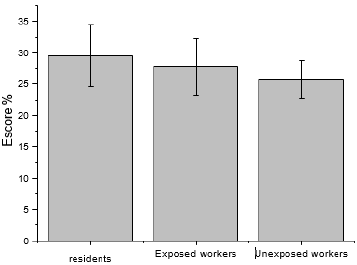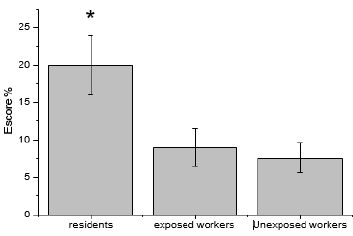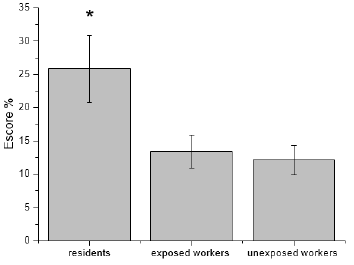Abstract
In the county of Caçapava do Sul, located at Rio Grande do Sul, the exploration of dolomitic limestone has great importance in the city’s economy, generating jobs, developing the gross domestic product, and improving the human development Index. However, some evils that are closely related to mining activity need to be investigated relatively frequently. The search for the safety of workers and communities living around the mining units is of interest to companies, the county, and the community. The Saint George Hospital questionnaire (SGRQ) is a valuable tool in assessing people with chronic respiratory disease quality of life. The objective of this study was to evaluate the applicability of the SGRQ to the quality of life of workers in mineral exploration companies and people who live close to mining activities; aimed at the application as a quality of life investigation tool, in a broader and more general way, as an application to people exposed to risk factors even before they have been diagnosed with chronic respiratory disease. Residents in the surroundings of the industrial district had the highest averages in the symptoms, activities, impacts, and total domains. Among the domains of the SGRQ, activities, and impacts are most directly related to the quality of life. Thus, putting in evidence the group of residents of the industrial environment concerning the reduction in the life quality of the groups studied.
Keywords: Quality of Life, Respiratory Diseases, Dolomitic Limestone, SGRQ
Introduction
Air pollution significantly impacts health and is associated with
a high morbidity and mortality rate, mainly due to respiratory and
cardiovascular diseases [1,2]. Therefore, these health problems
are considered good indicators of impact on quality of life [3]. The
adverse health effects caused by particulate matter depend
on numerous variables, mainly individual factors, socioeconomic
conditions, and components of the pollution [4]. These effects
result in asthma, chronic bronchitis, Chronic Obstructive.
Pulmonary Disease (COPD), progressive pulmonary pathologies,
generating a considerable drop in quality of life. Several studies
relate mineral dust to respiratory diseases [5-12]. Caçapava do
Sul has a limestone production capacity greater than 1
million tons/year. Limestone mining is of paramount importance
for various sectors of the country’s economy, having varied
applications in agriculture, civil construction, metallurgy, paper,
and paint industries. However, the extraction and processing of
limestone can be harmful to workers and populations close to the
factories and result in several chronic respiratory changes [3].
Quality of life is the quantification of the disease impact on the
activities of daily living and well-being of the individual in a formal
and standardized way [13]. Thus, it highlights the importance of the
role of standardized quality of life questionnaire, which allows for
objective comparison through scores with absolute or percentage
numerical expressions. The SGRQ was developed in 1991 in the United Kingdom to be a standardized tool applicable to the study
of disabling respiratory diseases and related to the measurement of
quality of life [8,14-16]. The objective of this work was to evaluate
the applicability of the SGRQ in the quality of life of workers
from mineral exploration companies and people who live close to
the mining activity, applying it as a tool for investigating the quality
of life more broadly, to people exposed to risk factors for chronic
respiratory disease, even before the diagnosis of the disease.
Material and Methods
The SGRQ was used to analyze, through pre-established
standards, the quality of life of the people evaluated, 76 items,
divided into three domains: Symptoms, Activity, and Impact. The
‘Symptoms’ domain assesses the level of symptoms, discomfort
due to respiratory symptoms, including frequency of coughing,
sputum, and shortness of breath. The ‘Activities’ domain assesses
the limitations and changes in individuals’ physical activities.
The third domain is ‘impacts,’ which assesses the global impact
on activities of daily living and the individual’s well-being. The
data obtained were inserted in a specific spreadsheet called ‘SGRQ
Calculator’ responsible for performing the sum calculations and
providing the individual scores (symptom, activity, and impact)
and the total.
Scores are calculated by adding the weights of the alternatives
marked as positive for each domain, divided by the total of all
weights for that specific component, such as:
Scores = 100 x sum of the weights of the marked items of the
component
Sum of weights of all component items A ‘Total’ score
summarizing all items is calculated by dividing the sum of the
weights of the marked alternatives of the three domains by the
sum of the weight of the entire questionnaire.
Total score = 100 x sum of all weights of the items marked in
the questionnaire
The total sum of the weights of all items in the questionnaire
each item has a specific weight.
The scores vary from 0 to 100 and are expressed as a
percentage. Values below 10% indicate normality, with a higher
score meaning worse performance in each domain and worse
health-related quality of life. The Ethics approved this study in the
Human Research Committee of the Federal University of Pampa.
Data collection, eighty-nine interviews happened within the
companies, and another 80 with the population living around the
mining companies, totaling 169 questionnaires. The consent of all
individuals submitted to research was obtained after the methods
and objectives of the study were explained, and then the SGRQ was
applied anonymously, divided into the following groups:
Unexposed workers group: company employees not directly
exposed to limestone dust (office workers, mechanics, and truck
drivers), n = 12;
Exposed workers group: employees who are directly
exposed to limestone dust (Employees who work with lime,
mortar, dismantling and grinding of limestone,
Fertilizer factory, bagging, storage, and loading of limestone) n
= 75;
Residents’ group: residents of residences that are close to
mining companies n = 80.
Statistics Analysis
Results were expressed as mean and ± standard deviation (SD), using a one-way analysis of variance (ANOVA). Differences between groups were determined using Tukey’s multiple comparison test (Origin lab pro for Windows, Origin Lab 2003, and Northampton, MA). The difference between the groups was considered significant when P <0.05.
Results and Discussion
As the daily activities of the person with chronic respiratory disease start to be compromised, specific impacts on the behavior and the lives of these individuals begin to be observed. This work collected data from the domains’ symptoms, activities, and impacts, showing the influence of mining activity on the population’s quality of life exposed to risk factors. The result of the symptoms domain did not show significant variation between the three groups. This fact suggests that there may be compensation in the respiratory system of the exposed population at this moment (Figure 1). The group of residents showed significant variation in the activity domain compared to the groups of unexposed and exposed workers. The high average of this domain in the residents’ group concerning the other two groups demonstrated that the surrounding residents have more limitations and changes in physical capacity than the two groups of workers (Figure 2). This result is probably due to PPE use since NR-6 and Federal Law No. 6, 514 standardize and regulate the mandatory use of this equipment during employment and mining. In addition, there is the fact that the companies studied promote activities that aim to mitigate the dispersion of particulate material, such as collective safety devices, which help to retain particulate material in the soil. However, the residents’ group does not have any of these measures mentioned above; and receives the cargo of particulate material from several mining companies disposed of several times meters away from the residences. The Impacts domain also showed a significant difference when compared to the unexposed workers and exposed workers groups.
Figure 1: Represents mean and standard deviation of the symptoms domain of the groups: residents, exposed workers, and unexposed workers.
Figure 2: It represents the mean and standard deviation of the activity domain of the groups: residents, exposed workers, and unexposed workers. * (P <0.05).
The high score of this domain in the residents’ group shows that the individuals in this group have a more significant global impact on their daily activities, probably due to environmental factors that limit the well- being of individuals (Figure 3). The total score summarizes the three domains: symptoms, activity, and impact, and the significantly increased average in the residents’ group show that the population living in the vicinity of the limestone exploration companies has a more significant impairment of health status than the individuals who work in these companies (Figure 4). The group of workers, exposed and unexposed, had a total score very close to 10 in the total score, which suggests normality. In contrast, the results obtained in the residents’ group suggest that its indirect exposure is probably causing severe damage to the respiratory capacity of this population, which does not have protective measures and is constantly exposed to mineral dust from several mining companies, corroborating the founding in the literature [2,5,6,11,17].
Figure 3: Represents mean and standard deviation of the domain Impact of groups: residents, exposed workers, and unexposed workers. * (P <0.05).
The fact that the group of residents in the surroundings of the industrial district had higher averages in the domains activities, impacts, and total, even in a group of individuals not previously diagnosed with COPD, draws attention to the possible use of the SGRQ as a tool to be also used for epidemiological purposes in individuals continuously exposed to risk factors for respiratory disease. Furthermore, among the domains of the SGRQ, activities and impacts are most directly related to the quality of life, putting the residents’ group in evidence when assessing a reduction in quality of life. This study aimed not to make a medical diagnosis through the use of SGRQ nor to classify the populations studied as to the stages of COPD. Instead, use a reliable and established tool to collect data that promotes hypotheses that continue to be studied. Moreover, that encourages new jobs in the region.
Conclusion
Exposure to dust from mining activities is a risk factor for the health of those exposed to it as workers and residents of the surroundings of the industrial district, making them susceptible to respiratory diseases and, consequently, loss of quality of life.
References
- AI Tiotiu, Plamena Novakova, Denislava Nedeva, Herberto Jose Chong-Neto, et al. (2020) Impact of air pollution on asthma outcomes, International Journal of Environmental Research and Public Health. 17(17): 1–29.
- L Sesé, Hilario Nunes , Vincent Cottin, Shreosi Sanyal, Morgane Didier, et al. (2018) Role of atmospheric pollution on the natural history of idiopathic pulmonary fibrosis, 73(2): 145-150.
- D Knight, R Ehrlich, K Fielding, H Jeffery, A Grant, et al. (2015) Trends in silicosis prevalence and the healthy worker effect among gold miners in South Africa : a prevalence study with follow up of employment status, BMC Public Health. p. 1-9.
- RB Hamanaka, GM Mutlu (2018) Particulate Matter Air Pollution: Effects on the Cardiovascular System, Frontiers in
- G WORTH (1992) Lung function in silicosis. Grundfragen aus der 4: 361-373.
- I Tomos, K Dimakopoulou, ED Manali, SA Papiris, A Karakatsani (2021) Long-term personal air pollution exposure and risk for acute exacerbation of idiopathic pulmonary fibrosis, Environmental Health: A Global Access Science 20(1).
- SA Shah, C Velardo, A Farmer, L Tarassenko (2017) Exacerbations in chronic obstructive pulmonary disease: Identification and prediction using a digital health system, Journal of Medical Internet Research. 19(3): 1-14.
- CP Engström, LO Persson, S Larsson, M Sullivan (2001) Health-related quality of life in COPD: Why both disease-specific and generic measures should be used, European Respiratory 18(1): 69–76.
- MA Arbex, UdeP Santos, LC Martins, PHN Saldiva, LAA Pereira, et al. (2012) Air pollution and the respiratory system, Jornal Brasileiro de Pneumologia. 38(5): 643–655.
- P Daniel Harris, BA Lynn McNicoll, MD Gary Epstein-Lubow, MD, Kali S Thomas (2017) Suckling rat cardiac muscle extraction HHS Public Access, Physiology & 176(1): 139-148.
- W Gründorfer, A Raber (1970) Progressive silicosis in granite British Journal of Industrial Medicine. 27(2): 110-120.
- (2014) Undervisningsministeriet, Enhanced pdf. p.1.
- PW Jones (2001) Health status measurement in chronic obstructive pulmonary Thorax 56(11): 880-887.
- Ferrer, C Villasante, J Alonso, V Sobradillo, R Gabriel, et al. (2002) Interpretation of quality of life scores from the St George’s Respiratory Questionnaire, European Respiratory Journal. 19(3): 405-413.
- A Camelier, FW Rosa, C Salmi, OA Nascimento, F Cardoso, et al. (2006 ) Avaliação da qualidade de vida pelo Questionário do Hospital Saint George na Doença Respiratória em portadores de doença pulmonar obstrutiva crônica: Validação de uma nova versão para o Brasil, Jornal Brasileiro de Pneumologia. 32(2):114-122.
- TC DE Sousa, JR Jardim, P Jones (2000) Validation of the Saint George's Respiratory Questionnaire in patients with chronic obstructive pulmonary disease in Brazil. 26(3).
- V Leso, L Fontana, R Romano, P Gervetti, I Iavicoli (2019) Artificial Stone Associated Silicosis : A Systematic Review. 16(4): 1–17.

 Short Communication
Short Communication



